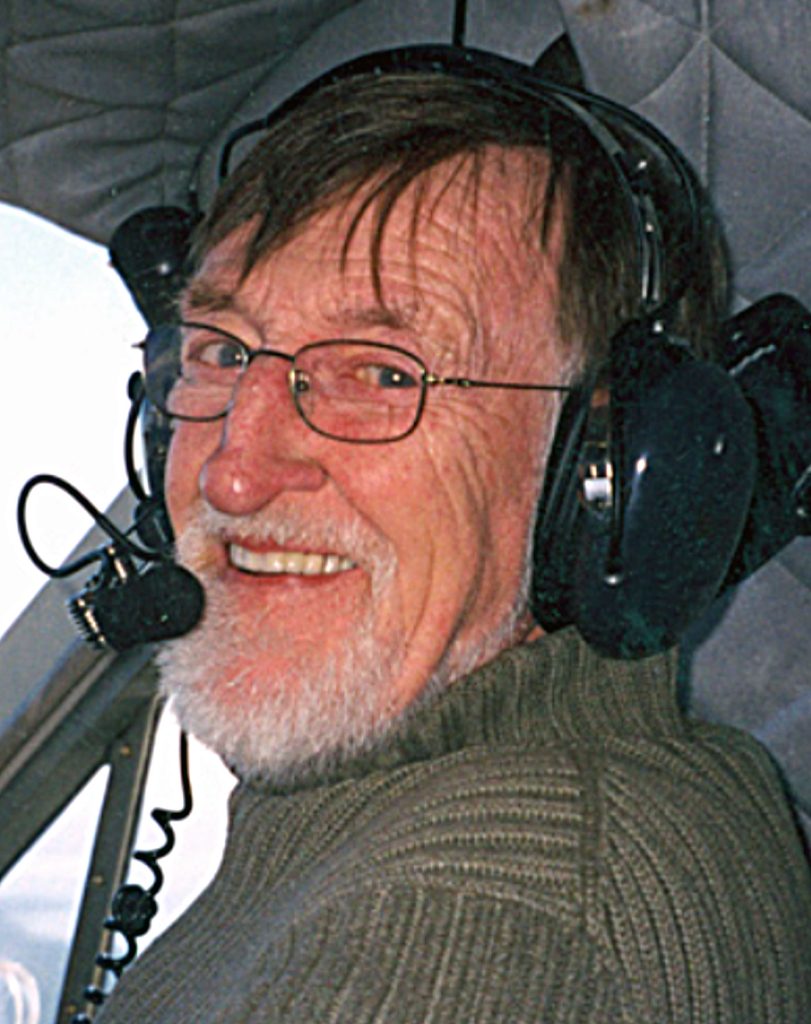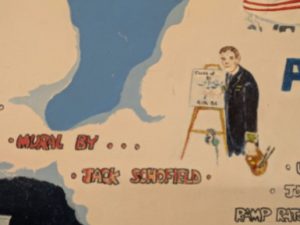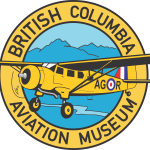In 1980, when Jack Schofield started sketching a Canso in the corner of a bleak institutional green wall in the pilot’s waiting room at Port Hardy Airport, he did not expect it to be the beginning of a celebration of the early days of flight in BC that would later be displayed in the British Columbia Aviation Museum. In an early interview with the Museum library staff, he dryly commented that had he known how famous it would become, he would have taken a bit more time over it. He also thought, on reflection, that a Stranraer would have been more appropriate than the Canso.

Jack was one of the pilots for Air BC, flying Beavers, Otters and BN2 Islanders into logging camps, native villages and fishing resorts along the coast and inlets serviced from Port Hardy. Villi Douglas was the base manager at Port Hardy and was partly responsible for the bleakness of the wall, having ordered the removal of its previous array of scantily dressed pinups. When he saw Jack’s drawing, Villi was delighted and promptly provided the money for Jack to equip himself with all the paint and supplies he needed; furthermore, he paid Jack at the rate of the highest earning pilot each day until the project was completed. The mural eventually would include the name of pilots, mechanics and support staff working at the airport from its inception in 1945. Incidentally, the pinups found a new home in the engineers’ work area.
Jack’s involvement in aviation started in World War II when he joined the Royal Canadian Air Cadets. After the war, he learned to fly from Vancouver’s U-Fly and the Aero Club of BC on Tiger Moths and the new Cessna 120. He joined 442(F) Reserve Squadron at Sea Island, Vancouver, as a trainee aero engine technician while he worked for his commercial pilot’s license.
Jack had no success in finding immediate employment as a pilot, mainly due to the large number of experienced pilots returning from the war and seeking work in commercial aviation. While he waited for an opportunity, he continued to fly privately and worked for an electrical manufacturer. After 12 years of this, he got his first flying contract, operating a Cessna 172 for a First Nations organization, installing communication systems in coastal Native Villages. This was followed by four years as a flying salesman for electrical parts, operating between Prince Rupert and Victoria.
In 1972, Jack became “The One Man Airline” flying a Cessna 185 floatplane for a commercial airline out of a remote base on the mid BC coast. In 1978 he joined Gulf Air Ltd. as a line pilot. When Gulf Air was bought out by the Pattison group and became part of BC Air, Jack moved to Port Hardy where he stayed until 1982.

After leaving BC Air, Jack continued flying for a few more years, starting his own company, Orca Air, which operated for six years. After selling the company, he joined Trans Pacific Airways out of Port Hardy, followed by a short contract in NWT and a stint in the Western Arctic doing aerial surveying.
In 1990 Jack retired from flying and began writing about aviation. He started a magazine titled “BC Aviator”, containing his writings and illustrated with his own drawings. Initially only available in BC, the distribution spread eastward and the magazine name changed to reflect this. It became the “West Coast Aviator” and later, when it spread Canada wide, broadened to “Canadian Aviator”. The content retained a west coast flavour but new writers were added to encompass the whole Canadian aviation world.
“Coast Dog” was originally a term for Union Steamship captains who could navigate coastal inlets and waterways in dense fog by timing the return of the ship’s whistle, and perform other amazing navigational skills. With the end of the shipping business, the term was informally adopted by pilots who could fly the coast without the aid of a map. Jack first heard the term from pilot Bill Gillies (not on the mural) and recalled it when naming his first book and his pre-press company. He has published a trio of books on his coastal days “Flights of a Coast Dog”, “No Numbered Runways” and “Coast Dogs Don’t Lie”. Packed with unique characters (often diplomatically anonymous) and the story telling tradition of pilots known as ‘hangar flying’, the books are testament to hanger flyer in chief, Jack’s, wicked sense of humour. His drawings can be found in his own books and those of other aviator authors, as well as in copies of the “Aviator” magazine in its various guises.
Jack was born September 1927 a few months after Charles Lindbergh made the first transatlantic flight. He has three children of his own and two of his wife, Colleen. Together they have a standard poodle “Beau”. He retired to Mayne Island but now (2024) is in Saan Pen Extended Care, where he continues to work and write.
Select here to watch an interview of Jack which took place at the BC Aviation Museum in 2024.
